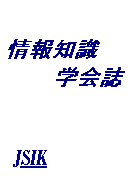Volume 32, Issue 4
Displaying 1-14 of 14 articles from this issue
- |<
- <
- 1
- >
- >|
-
2022Volume 32Issue 4 Pages 369-370
Published: December 18, 2022
Released on J-STAGE: January 27, 2023
Download PDF (186K) -
2022Volume 32Issue 4 Pages 371-374
Published: December 18, 2022
Released on J-STAGE: January 27, 2023
Download PDF (586K) -
Exploring the Structure of Texts, and Conveying to Others: The Case of Japanese Earlier Dictionaries2022Volume 32Issue 4 Pages 375-378
Published: December 18, 2022
Released on J-STAGE: January 27, 2023
Download PDF (3629K) -
2022Volume 32Issue 4 Pages 379-382
Published: December 18, 2022
Released on J-STAGE: January 27, 2023
Download PDF (2094K) -
2022Volume 32Issue 4 Pages 383-388
Published: December 18, 2022
Released on J-STAGE: January 27, 2023
Download PDF (1171K) -
2022Volume 32Issue 4 Pages 389-392
Published: December 18, 2022
Released on J-STAGE: January 27, 2023
Download PDF (2764K) -
2022Volume 32Issue 4 Pages 393-405
Published: December 18, 2022
Released on J-STAGE: January 27, 2023
Download PDF (18552K) -
2022Volume 32Issue 4 Pages 406-409
Published: December 18, 2022
Released on J-STAGE: January 27, 2023
Download PDF (225K) -
2022Volume 32Issue 4 Pages 410-413
Published: December 18, 2022
Released on J-STAGE: January 27, 2023
Download PDF (412K) -
2022Volume 32Issue 4 Pages 414-415
Published: December 18, 2022
Released on J-STAGE: January 27, 2023
Download PDF (410K) -
2022Volume 32Issue 4 Pages 416-419
Published: December 18, 2022
Released on J-STAGE: January 27, 2023
Download PDF (518K) -
2022Volume 32Issue 4 Pages 420-423
Published: December 18, 2022
Released on J-STAGE: January 27, 2023
Download PDF (509K) -
2022Volume 32Issue 4 Pages 424-427
Published: December 18, 2022
Released on J-STAGE: January 27, 2023
Download PDF (614K) -
2022Volume 32Issue 4 Pages 428-431
Published: December 18, 2022
Released on J-STAGE: January 27, 2023
Download PDF (707K)
- |<
- <
- 1
- >
- >|
